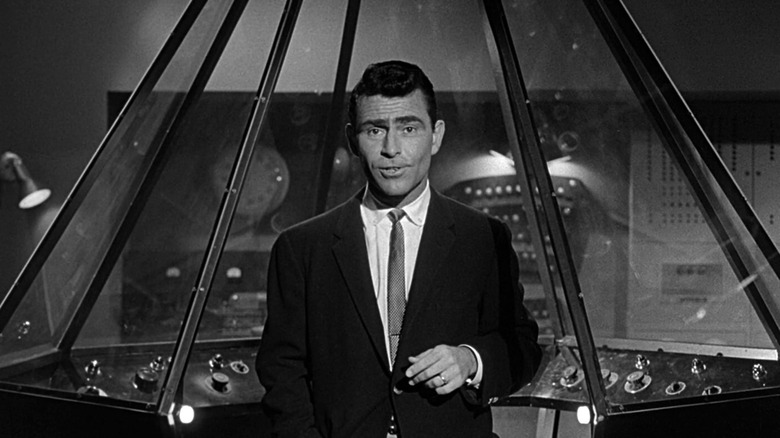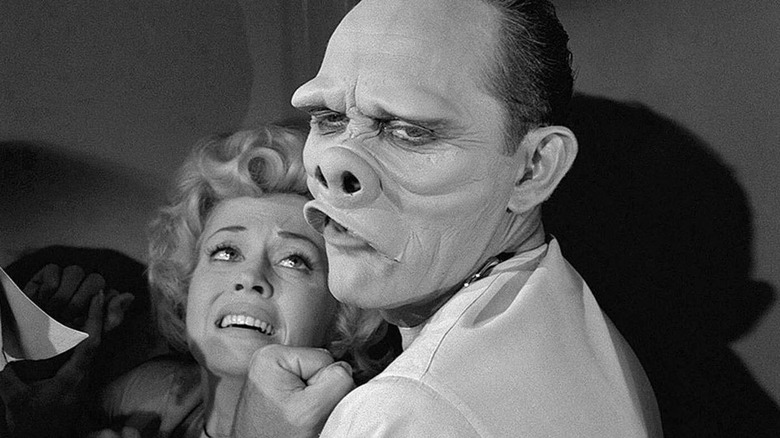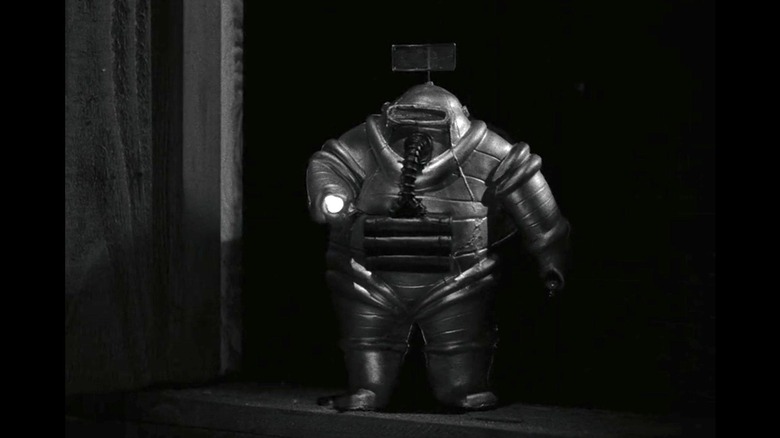The Twilight Zone's Biggest Failure, According To Creator Rod Serling
Rod Serling's eerie sci-fi anthology series "The Twilight Zone" still, to this day, tops lists of the best TV shows of all time. In a 2023 article in Variety, listing the 100 greatest shows of all time, it was listed at #14, just behind "Succession," although that ranking smacks of recency bias. The #1 show on that list, incidentally, was "I Love Lucy," which is wholly correct. Over here on /Film, we listed "The Twilight Zone" as the greatest horror TV show of all time, which is also correct. "Tales from the Crypt," however, didn't crack the top 30, so we may need to do some soul-searching.
The original "Twilight Zone" ran from 1959 to 1964, which is an astonishingly long run for an anthology series. In that time, the show attracted numerous notable sci-fi writers and aspiring directors, bringing genre writing deeper into the pop consciousness. Serling became a minor deity of sorts, appearing at the heads and tails of "The Twilight Zone" to declare a stern moral for a shaken audience. Be just and fear not, gentle viewers, else the universe will enact its own form of karmic justice. "The Twilight Zone" became mythic.
Rod Serling, however, felt that the show had its share of dregs. For every great episode, there was at least one terrible episode to balance it out.
In 1970, Serling held an on-camera interview with Professor James Gunn (not to be confused with the superhero filmmaker James Gunn), which was almost lost to time. The interview was meant to be part of a Centron interview series, but it was canned when Centron couldn't acquire the rights to show clips of "Twilight Zone" interviews. It was shelved and presumably lost to time. Years later, all that remained was a silent workprint. Luckily, the audio elements were discovered elsewhere, and restorers painstakingly re-synched them.
The interview revealed Serling's opinions on the inconsistency of "The Twilight Zone," largely springing from the show's frustratingly low budget.
Good some weeks, bad other weeks
Six years after the show's cancelation, Gunn asked Serling if he was ultimately pleased with how "The Twilight Zone" turned out. Serling quickly replied:
"By and large. I think it failed in terms of its consistency. It was very good some weeks, quite bad other weeks. But this I think is pretty much the track record of most television by virtue of its desperate overexposure and the brevity of time allotted to us to produce something that is qualitative. But overall, I would say that it was a creative series. We did much more creating than we did imitating. I think we tried things. We failed frequently and succeeded other times."
Serling theorized that "The Twilight Zone" lingered with viewers because they could sense the show's efforts to make something striking and new, even if they didn't always succeed. He also said that audiences were drawn in because they were able to attract such a wide variety of acting talent ... that would agree to work for cheap. Serling admitted that, even when "The Twilight Zone" was allocated a bigger budget, it still only topped off at about $70,000 a week, which, he points out, was far, far cheaper than modern shows; Serling's own "Night Gallery" spent $250,000 a week.
Later in the interview, Serling admitted that the budgets were an issue. He envisioned something grander for "The Twilight Zone," and he simply didn't have the resources to make the visual effects he wanted. It wasn't a matter of getting the most from every penny. It was simply a matter of not being able to do it. He said:
"I would never try to beat my head against the wall, trying to come in at an arbitrary budget at the time. We simply couldn't do it properly. All we could use because we couldn't afford opticals and couldn't afford montage effects, were little wind-up rubber men. I thought it totally destroyed the illusion."
That's a reference to "The Invaders," one of Serling's favorite episodes of the series.
Rod Serling's favorite episodes
Serling also confessed his two favorite episodes of "The Twilight Zone" in the interview with Gunn. He was very fond of the Richard Matheson-penned episode "The Invaders" (January 27, 1961). In "The Invaders," an elderly woman (Agnes Moorehead), living alone in an isolated cabin, comes across a crashed flying saucer on her roof. The saucer is tiny, however, meaning the aliens inside much be only about five inches tall. Sure enough, she begins seeing miniature silvery astronauts creeping about her home. She attacks them, and they retaliate with high-tech weapons. The twist: the alien craft, in fact, came from Earth and landed on a planet populated by giants. Agnes Moorehead is a gigantic space alien.
Serling called the episode "pure science fiction with a very O. Henry-ish twist."
Serling's other favorite was one he wrote himself, "Time Enough at Last" (November 20, 1959), based on a short story by Lynn Venable. That's the episode with Burgess Meredith as an introverted bookworm who hates how much his extroverted co-workers demand he stop reading. While reading in a basement bank vault, the nuclear apocalypse strikes, killing everyone above. Meredith emerges to find the library intact. He is ecstatic. He finally has the time and solitude he always wanted to read, read, read. Then his glasses break.
It was, according to Serling, "sheer, pure, beautiful irony." He also said that, "in terms of production values," the episode was "gorgeously done." He was able to film the post-apocalypse scenes on the MGM backlot, and "it looked like a movie."
Serling then lamented that Richard Matheson didn't have the budget he wanted. The showrunner love Matheson's writing, but felt that the rubber robots were a little corny. Sometimes, one merely has to work with the budget they are given.


